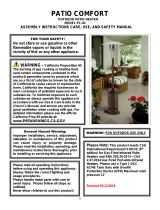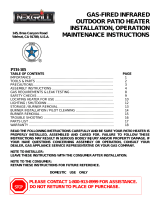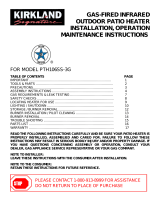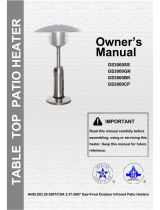Page is loading ...

P/N 65135-6/21 Copyright © 2021 By Infrared Dynamics, Inc. Printed in USA
Sunglo®
Patio Heater
MODEL A270
Gas-fired Infrared Patio Heater
Propane Gas
FOR OUTDOOR PORTABLE USE ONLY
Not for use in residential dwellings
DANGER
If you smell gas:
1. Shut off gas to the appliance.
2. Extinguish any open flame.
3.
If the odor continues, keep away from the
appliance and immediately call your gas
company.
DANGER
DO NOT
store or use gasoline or other
flammable vapors and liquids in the vicinity of
this or any other appliance.
An Propane Gas cylinder not connected for use
shall not be stored in the vicinity of this or any
other appliance.
WARNING
Improper installation, adjustment, alteration,
service or maintenance can cause property
damage, injury or death. Read the
installation, operating and maintenance
instructions thoroughly. before installing or
servicing this heater.
WARNING: CA Prop 65
Please Note the following:
If not installed, operated and maintained in
accordance with the manufacturer’s
instructions, this product can expose you to
substances in the fuel or from combustion
including carbon monoxide, resulting in death
or serious illness and which are known to the
State of California to cause cancer, birth
defects or reproductive harm. For more
information go to
www.P65WARNINGS.CA.GOV
It is the sole responsibility of the purchaser
to check for and comply with any local or
national standards or restrictions as they
pertain to the installation of outdoor
heaters before purchase.
High Altitude
Installation of this appliance at altitudes above
2,000 (610 m) shall be in accordance with local
codes, or in the absence of local codes,
ANSI Z224.1/NFPA 54 or CSA B149.1.
TO THE INSTALLER:
Leave this manual with the
owner after installation.
TO THE OWNER:
Keep this manual in a safe place in
order to provide your service technician with necessary
information for future reference.
Manufactured By:
Infrared Dynamics, Inc.
3830 Prospect Avenue
Yorba Linda, CA 92886
(888) 317-5255

2
Installation, Operation and Maintenance Instructions for the
Sunglo® Model A270 Gas-fired Patio Heater
INSTALLATION
Important Safety Rules
1. Children and adults should be alert to high
surface temperatures of areas above the post
when operating this heater.
2. Children should be carefully supervised when
they are in the area of the heater.
3. NEVER hang anything including clothes and
other flammable items on the heater.
4. DO NOT operate this heater unless it is fully
assembled with reflector in place.
5. Installation and repair should be done by a
qualified service technician. The heater
should be inspected before use and at least
annually by a qualified service technician.
More frequent cleaning may be required as
necessary. It is imperative that the control
compartment, burner and circulating air
passages of the heater be kept clean.
Prior to assembling your Model A270 propane
heater, the following must be reviewed.
Compliance with the following should yield
satisfactory heater operation. These instructions
should be retained for future reference. The
installation must conform with local codes or local
authority having jurisdictions.
1.
The Model A270 gas-fired infrared patio heater
is intended for heating residential and non-
residential outdoor areas. When the appliance
is connected to a fixed piping system, the
installation must conform with local codes or, in
the absence of local codes, with the National
Fuel Gas Code, ANSI Z223.2/NFPA 54, Natural
Gas and Propane Installation Code, CSA
B149.1 or Propane Storage and Handling
Code, B149.2.
2.
This Appliance shall be used only in a well-
ventilated space and shall not be used in a
building, garage or any other enclosed area.
This appliance may be installed in a shelter no
more inclusive than:
a.
With walls on all sides but no overhead
cover.
b.
Within a partial enclosure which includes an
overhead cover but no more than two side
walls. These side walls may be parallel, as in
a breezeway, or at right angles to each other.
c.
Within a partial enclosure which includes an
overhead cover and three side walls as long
as 30% of the horizontal periphery is
permanently open.
3.
Proper clearance from combustible materials
must be maintained at all times. The minimum
clearances are as follows:
Minimum Clearance from Combustibles
Side 24” (61 cm)
Rear 24” (61 cm)
Ceiling 18” (46 cm)
Below 84” (214 cm)
Combustible materials are considered to be
wood, compressed paper, plant fibers, plastic,
Plexiglas or other materials capable of being
ignited and burned. Such materials shall be
considered combustible even though flame-
proofed, fire-retardant treated or plastered.
Additional clearance may be required for glass,
painted surfaces and other materials which
may be damaged by radiant or convection heat.
4.
Heaters must be placed on a level area with
adequate footing and be readily accessible.
The heater may be permanently attached to the
floor utilizing the Floor Clamp Kit (Part No.
27020) available from the manufacturer.
5.
The gas manifold supply pressure must be
regulated at 11” water column utilizing a U/L
listed regulator. Any replacement regulator
must be U/L listed. The minimum inlet pressure
to the regulator from the tank is 5 PSI and
maximum pressure is 150 PSI.
6.
The heater must be inspected before each use,
and at least annually by a qualified service
person.
a.
The appliance area must be kept clear and
free of combustible materials, gasoline and
other flammable vapors and liquids.
b.
Gas jets and burner must be kept clear of
dirt and cobwebs. Flow of combustion and
ventilation air through the perforated portions
of the heater must not be obstructed.
c.
All gas connections should be checked for
leaks using a soap solution. Never use a
flame for this purpose.
d.
The flame pattern at the emitter grid should
be visually checked whenever heater is
operated (see figure 1.). If flames extend
more than ½ inch beyond surface of the
emitter grid or black soot is accumulating on
the emitter grid or reflector, the heater should
be turned off immediately. The heater should
not be operated again until repairs are made.
e.
Any cleaning agent used on the heater
should be of a non-combustible and non-
corrosive nature.

3
f.
The stainless-steel emitter grid normally does
not require cleaning and should NEVER be
painted. The reflector may be cleaned, but
never painted.
7.
The hose assembly shall be properly located
out of pathways where people may trip over it.
The hose must be protected from contact with
hot or sharp surfaces both during use and while
in storage. The hose assembly shall be visually
inspected prior to each used of the heater. If
excessive abrasion or wear is evident, or the
hose is cut, it must be replaced prior to
operating the heater. The replacement hose
regulator, Part #90017-4, may be obtained from
manufacturer or sales representative. See parts
list.
8.
DO NOT use any pressure regulator or hose
assembly other than those supplied with the
appliance. Replacement pressure regulator and
hose assembly must be those specified by the
manufacturer. Replacement parts may be
obtained from the manufacturer or your local
sales representative.
9.
This appliance is designed to operate with a
standard five (5) gallon propane tank. The
propane cylinder must be:
a.
Be constructed and marked in accordance
with the specifications for propane gas
cylinders of the U.S Department of
Transportation (DOT); or the Standard for
Cylinders, Spheres and Tubes for
Transportation of Dangerous Goods,
CAN/CSA-B339, as applicable:
b.
Provided with a listed overfilling device; and,
c.
Provided with a cylinder connection device
compatible with the connection for the
appliance.
10.
Propane tank must be secured to the heater
with protective chain provided. The cylinder
must be positioned upright for proper vapor
withdrawal. The cylinder must include a collar
to protect cylinder valve.
The following precautions regarding the propane
tank must be observed:
a.
Do not store a spare propane gas cylinder
under or near this appliance.
b.
Never fill the cylinder beyond 80% full.
11.
Tank connector fittings must be maintained in
good condition. A leak test should be performed
with soapy water whenever a new tank
connection is made. NEVER use a match to
test for leaks.
12.
Propane tank must be turned off whenever the
heater is not in use. When the heater is to be
stored indoors, the connection between the
propane cylinder and the heater must be
disconnected and stored in accordance with
Chapter 5 of the Standard for Storage and
Handling of Liquefied Gases, ANSI/NFPA 58.
13.
The A270 Sunglo Heater has been designed
with several safety features. These include
100% safety shutoff control, elevated heating
element, weighted base, and tank quick connect
coupling. Any modification to the heater not
described in the installation instructions may
compromise the safety of this appliance. Of
special concern is the following:
(1)
DO NOT shorten post length;
(2)
DO NOT bypass thermocouple safety;
(3)
DO NOT operate heater without a reflector;
and
(4)
DO NOT remove filler from weighted base.
Clothing or other flammable materials should not
be hung from the heater, or placed on or near
the heater. The area above the post may be
extremely hot. Direct contact with these metal
surfaces should be avoided in order to prevent
burns or clothing ignition.
Figure 2. TYPE 1 Connector

4
•
The Original
Outdoor Patio Heater

5
HEATER HEAD ASSEMBLY
Replacement Parts List
Item Part No. Description
1 70017 Nut, ¼-20 Hex SST
2 70024 Washer, ¼ SAE SST
3 10261 Reflector, PH
4 70006 Bolt, ¼ x ¾ Hex
5 70033 Washer, ¼ Inter SST
6 27006 Assy, PH Emitter Grid
7 70065 Wingnut, ¼ - 20 SST
8 30225 Shield PH Head
9 30202 Pan, PH Head
10 70072 Screw, #8 x ½ PP ‘F’ SST
11 30204-1 Cylinder, PH Perf
12 27007 Assy, PH Burner
13 70030 Clamp, 1”
14 35001-49 Orifice, #49 DS (Propane)
15 35012 Adapter, Orifice 3/8
16 90004-3 Control, 7000 MLC Propane
17 80005 Nipple, ½ x 2-1/8 Blk
20 27018-1 Assy, PH Head Base
21 90031 Thermocouple, T-46 18 IN
22 80031 Tubing, AL-1/4 x 14L
23 90022 Pilot, Propane #27920
24 90016 Propane Pilot Orifice
26 27025 Assy, 7000 Handle
27 30213 Channel, PH Pilot
28 70020 Screw, #10 x 1-1/4 SST
29 30299 Cover, PH Pilot Hole
30 80026 Tubing Fastener, ¼”

6
HEATER ASSEMBLY MODEL A270
Step 1.
a.
Remove Pipe Assembly from Post Package
and thread pipe onto heater base. Use 2
wrenches at least 12” long to tighten pipe to
heater base. If Teflon tape is not provided gas
pipe sealant should be used at this joint.
b.
Slide Pipe Assembly with header attached into
the top of the post and secure heater to post
with the four screws provided.
NOTE Post label should face front.
WARNING: Remove any dust cap or paper
covering which may block the flow of gas
Step 2.
a. Secure “L” brackets to heater base with hex
head bolts, spacers nuts, and lock washers
provided.
b. Secure socket assembly to “L” brackets as
shown below using the hex head bolts, lock
washers, and acorn nuts provided.
c. Install chain kit onto “L” brackets using holes
provided.
d. Slide Decorative cover down over post
socket.
Step 3.
a. Slide post down into socket with pipe
extending through hole in the bottom of the
socket.
b. Slide Decorative cover up around post.
c. Attached the hose to pipe assembly with quick
connect adapter.
d. Secure reflector to top of heater head. Use flat
washers above and below reflector holes.
e. Set tank into place and secure with safety
chain.
f. Connect regulator to tank.

7
Model A270
Propane Portable Patio Heater
Base Parts List
Item
Part No.
Description
1 60008-1 Lighting Instructions
2 30280 Post, A270 – 45” L
3 80006-4 Pipe, 42” L Black
4 70011 Nut, 3/8 Acorn
5 70013 Washer, 3/8 Lock
6 70007 Bolt, 3/8 x ¾ Hex
7 70028 Eyebolt, 3/8 w/ Nut
8 70012 Bolt 3/8-16 x 1-1/4
9 70059 Nut, 3/8”
10 10264-4 Assy, A270 Base
11 30279-5 Univ “L” Bracket (24)
12 70029 Hook, 1-1/2” S
13 70027 A270 Chain
14 27033 Assy, A270 Dec Cover
15 90017-4 Assy, Reg/Hose QCC1
16 27002-4 Assy, A270 Socket
17 80085 Reducer, ½” x ¼ “
18 90078 Adapter, #250
19 27020 Floor Clamp Kit

8
Model A270
DSI – Spark Ignition
System
Portable Propane Patio Heater
Item Part No. Description
1
90065-3
Electrode with lead
2 70037 Screw, #8-32 x 3/8
3 70038 Nut, #8-32
4 30623-3 Igniter Cover
5 70072 Screw, #8-32 x ½ SST
6 60623 Bracket, A270 Igniter
*7
30629
Plate, Igniter Ground
8 90072 Battery, AA 1.5 Volts
9 90071 Igniter, BP-E1
*10
70066
Screw #10-24 x .25
11 30204-5 Cylinder, PH Perf
*Item not shown

9
Propane Safety
To disconnect the coupler, first, make sure the main tank
valve is turned off. Grasp the coupler and turn counter
clockwise and the inlet will then disengage.
Propane Gas is heavier than air fuel that requires basic
safety precautions. Take the time to read the safety
precautions in this manual and on the propane tank.
Consult your propane supplier in regards to safety
handling and transport of your propane tank.
The A270 heater comes equipped with a hose and
regulator for connection to a standard 20 lb. propane
cylinder. All fittings necessary to attach the
hose/regulator to the heater are included. The propane
tank is not included. Operating pressure is 11.0” W.C.
Propane Tank Requirements
A dented or rusty propane tank may be hazardous and
should be checked by your propane gas supplier. Never
use a cylinder with a damaged valve. Always check for
leaks after every propane tank change.
The propane gas cylinder must be constructed and
marked in accordance with the specifications for
propane gas cylinders of the U.S. Department of
Transportation (DOT) and designed for use with a Type
1 system only. DO NOT change the regulator/hose
assembly from that supplied with the unit or attempt to
use other types of tank connections.
Propane Tank Connections
Connect the Regulator to the tank (with the tank valve
fully closed). Although the flow of gas is stopped when
the Type 1 system is disconnected, you should always
turn the propane tank main valve off after each use and
during transport of the tank or heater. Insert the
regulator inlet into the tank valve and turn the black
coupler clockwise until the coupler is tight. Do not
over-tighten the coupler.
Test for Leaks
Leak tests must be performed with soapy water each
time the tank is re-connected to the heater. Once the
propane tank is connected open the tank valve. Apply
soapy water with a spray bottle or small paint brush
around tank valve and hose connections. If bubbles
appear, repair of the heater or tank is required before
the heater is operated.
Cylinders must be stored outdoors in a well-ventilated
area out of the reach of children. If the appliance is
stored indoors, the propane cylinder must be removed
from the appliance and stored outdoors. DO NOT store
a spare propane cylinder under or near this appliance.
NEVER fill the cylinder beyond 80 percent full. For
appliances designed to use a CGA No. 791 Connection.
“Place the dust cap on the cylinder valve outlet
whenever the cylinder is not in use. Only install the type
of dust cap on the cylinder valve that is provided with the
cylinder valve. Other types of caps or plugs may result in
leakage of propane.
CYLINDER VALVE HAND WHEEL
PRESSURE
RELIEF
VALVE
x
POINT OF
CONNECTION
CYLINDER x
x
x
x
LIQUID LEVEL
DO NOT check for gas leaks with a match or open
flame. Apply soapy water at areas marked “X”. Open
cylinder valve. If bubbles appear,
close valve and have
an LP
-Gas service person make needed repairs. Also
check appliance valves and connections to make sure
they DO NOT leak before lighting appliance.
WARNING
Only qualified persons are
permitted to fill propane cylinder.
Never attempt to repair a propane
cylinder.
DO NOT allow children to play or
tamper with propane cylinders.
When transporting, keep cylinder
secured in an upright position with
the cylinder valve turned off.
Store cylinders outdoors in a well
ventilated and secure area.

10
TEST FIRING HEATER
Test fire heater, following the lighting instructions on heater post. Leak test all gas connections with soapy
water. Soap bubbles indicate gas leakage. Do NOT use a match to test for gas leaks.
WARNING: White smoke may appear around the emitter grid during the first minute of the initial firing.
TROUBLE SHOOTING
Problem
Pilot won't light
Pilot won't stay lit
Main burner won't light
Limited Warranty and Service
Possible Causes
•
Air in gas line
•
Low gas pressure
•
Gas line turned “Off” at the propane tank
•
Propane gas tank is empty
•
Bad thermocouple
•
Corrosion of thermocouple contact
•
Bad Valve
•
Wind exceeding 10 mph
•
Low gas pressure
•
Blockage in orifice
•
Manual valve not in “On” positi
Heaters carry a 90-day commercial or one-year residential factory warranty. All heaters are stamped with the
date of manufacture. In most cases, your dealer or sales representative will handle the warranty procedure
for you. If there is no sales representative available, the heater head and regulator may be returned to the
factory for repair. Warranty is limited to repair of heater at the factory or replacement parts. Any work or
repair of this heater must be performed by qualified service personnel. Infrared Dynamics, Inc. will not be
liable for any other expense to the customer, except as stated above.
To Light Pilot
Rotate control knob to “Pilot” position. Firmly
depress knob for 30 seconds while lighting pilot
through ½” dia. lighting hole above control. Pilot
should remain lit.
NOTE: Allow 1½ minutes to purge air through pilot
after connection with a new tank of propane gas.
To Turn Heater On
Turn control knob to “On” position.
To Turn Heater and Pilot “Off”
Turn knob to “Pilot” position. Depress slightly and
turn to “Off” position. Wait 5 minutes after complete
shutoff of heater before relighting pilot. Turn “Off”
gas tank when heater is not in use.
Manufactured by
INFRARED DYNAMICS
, INC.
Yorba Linda, CA 92886 U.S.A.
Tel: (714) 572-4050 Fax: (714) 572-6093
Toll-Free: (888) 317-5255
www.infradyne.com
2CHL2
Pilot
Robert Shaw
Series 7000
Valve Knob
/











